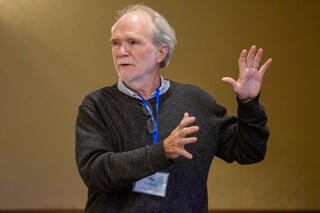
Midwestern farmers could play an immediate and significant role in fighting climate change by adopting practices that trap more carbon in the soil, according to a nationwide analysis of strategies for removing greenhouse gasses from the atmosphere.
The findings, based in part on research led by scientists with the Great Lakes Bioenergy Research Center (GLBRC), are part of a landmark report that charts a path for the United States to achieve a net-zero greenhouse gas economy by 2050, a goal established last year by the Biden administration.
The report concludes that with current technologies, the nation could remove a billion metric tons of carbon dioxide per year by increasing the carbon uptake of forests and agricultural lands, converting waste biomass to fuels, and using purpose-built machines to remove carbon dioxide from the air.
A collaborative effort of 68 researchers at 13 institutions spearheaded by the Lawrence Livermore National Laboratory, the study draws on research by Michigan State University professors Bruno Basso and Phil Robertson into how carbon dioxide can be captured from the atmosphere using bioenergy and cropland-soil management solutions.
Basso and Robertson are co-investigators with GLBRC, a federally-funded research hub based at the University of Wisconsin–Madison that is working to develop cost-effective ways to derive fuel and other chemicals from non-food plants.

This first-of-its-kind study evaluates different approaches for removing carbon dioxide from the atmosphere at a national level in terms of both cost and capacity and provides county-level potential for economically viable carbon removal and storage.
“Worth noting is the novelty of this analysis,” said Robertson, a crop and soil scientist who studies field crop ecosystems. “This is the first large-scale analysis of carbon dioxide removal for the entire country that brings together all technologies in one place and places them in an economic context.”
Basso, whose work draws on biophysics, climatology, hydrology, genetics, agronomy, and soil science to better understand agricultural systems and improve decision making, designed crop simulation experiments to evaluate the potential contributions of bioenergy crops.
“We looked at the benefits of growing perennials — plants like switchgrass — that might be grown in unprofitable and nonproductive parts of crop fields,” Basso said. “The question became: How much carbon can we pull and store into the soil if we grow perennial crops for bioenergy?”
In order to meet goals outlined in the Paris Climate Agreement, which seeks to limit the most devastating impacts of climate change, the U.S. must quickly slash greenhouse gas emissions that primarily result from burning fossil fuels.
But that alone won’t be enough.
To offset residual emissions from activities like farming, heavy industry, and environmental feedback (such as when permafrost thaws), the nation will need to remove from the atmosphere and store at least a billion metric tons of carbon per year. The report concluded that doing so will annually cost roughly $130 billion in 2050, or about 0.5% of the current gross domestic product, while creating more than 440,000 long-term jobs.
It also concluded that using cropland-soil management solutions — in addition to those involving forest management, biomass carbon removal and storage, and direct air capture — could allow for even more carbon to be stored beyond the gigaton benchmark.

Based on their models, combined with those from economists in the project, Basso and Robertson concluded that by 2050, U.S. cropland could sequester 130 million metric tons of carbon dioxide, assuming an incentive of $40 per metric ton.
But the report cautions that carbon could be released back to the atmosphere if land management practices change and suggests that without guarantees of maintenance, soil-based CO2 removal and storage should be considered a temporary strategy until more durable methods can be implemented.
Nevertheless, rapid scale-up potential and low costs mean cropland-soil and forest management solutions are steps that can be taken immediately.
In addition, farmers can improve soil fertility and restore biodiversity to ecosystems by planting perennial crops.
“Two huge benefits come from this one solution,” Robertson said. “There’s both a climate benefit and a benefit to soil fertility, possibly even to biodiversity.”